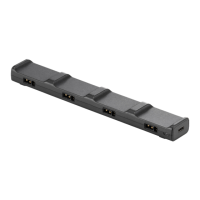DJI Avata
User Manual
23
© 2022 DJI All Rights Reserved.
Return to Home
The Return to Home (RTH) function brings the aircraft back to the last recorded Home Point and lands when
the GNSS signal is strong. There are three types of RTH: Smart RTH, Low Battery RTH, and Failsafe RTH. If the
aircraft successfully recorded the Home Point and the GNSS signal is strong, the RTH will be triggered when
either Smart RTH is initiated, the aircraft battery level is low, or the signal between the remote control device and
the aircraft is lost. RTH will also be triggered in other abnormal scenarios such as where video transmission is lost.
GNSS
Description
Home Point
20
The default Home Point is the rst location where the aircraft received a strong or
moderately strong GNSS signal (where the icon shows white). The aircraft status
indicator blinks green quickly and a prompt appears in the goggles to conrm the
Home Point has been recorded.
Smart RTH
If the GNSS signal is sucient, Smart RTH can be used to bring the aircraft back to the Home Point. Smart RTH
can be initiated or canceled by the remote control devices. After exiting RTH, users will regain control of the
aircraft.
Low Battery RTH
When the Intelligent Flight Battery level is too low and there is not enough power to return home, land the aircraft
as soon as possible.
In order to avoid unnecessary danger due to insucient power, DJI Avata will intelligently determine whether the
current battery level is sucient to return to the Home Point based on the current location. Low Battery RTH
is triggered when the Intelligent Flight Battery is depleted to the point that the safe return of the aircraft may be
aected.
RTH can be canceled by the remote control devices. If RTH is canceled following a low battery warning, the
Intelligent Flight Battery may not have enough power for the aircraft to land safely, which may lead to the aircraft
being crashed or lost.
The aircraft will land automatically if the current battery level can only support the aircraft long enough to descend
from its current altitude. The remote control devices can be used to alter the direction of the aircraft during the
landing process. Pressing the accelerator when using the motion controller during landing can make the aircraft
stop descending and fly at the current altitude to adjust the horizontal position. The aircraft will continue to
descend after releasing the accelerator.
Failsafe RTH
If the Home Point was successfully recorded and the compass is functioning normally, Failsafe RTH automatically
activates after the remote control signal is lost for more than 3.5 seconds.
The aircraft will y backwards for 50 m on its original ight route and enter Straight Line RTH. The aircraft enters
Straight Line RTH if the remote control signal is restored during Failsafe RTH.
The response of the aircraft when the wireless signal is lost can be changed in the goggles. The aircraft will not
execute Failsafe RTH if land or hover has been selected in the settings.
Other RTH Scenarios
A prompt will appear in the goggles and RTH will be initiated if the video download signal is lost during ight, while
the remote control devices can still be used to control the movements of the aircraft.

